Biology - B5 the human body
0.0(0)
0.0(0)
Card Sorting
1/71
Earn XP
Study Analytics
Name | Mastery | Learn | Test | Matching | Spaced |
|---|
No study sessions yet.
72 Terms
1
New cards
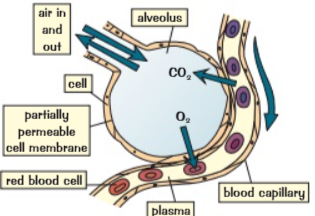
Alveoli
little air sacs found in the lungs where oxygen diffuses out into the blood and carbon dioxide diffuses into the air
2
New cards
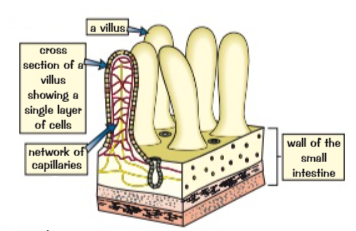
Villi
little projections in the small intestine which increase the surface area so that digested food is quickly absorbs into the blood by active transport.
3
New cards

Double circulatory system
In the first one, the heart pumps deoxygenated blood to the alveoli where it is then oxygenated and sent back to the heart. The in the second one, the oxygenated blood is pumped around all of the other organs in the body including exchange surfaces like villi where they take on nutrients and the kidneys where urea is removed. The now deoxygenated blood then returns to the lungs.
4
New cards
Vena Cava
an entry way into the heart (deoxygenated blood)
5
New cards
Pulmonary vein
A vein into the heart (oxygenated blood)
6
New cards
Atria
the first chambers in the heart which contract to force blood into the ventricles (Right = Deoxygenated Left = Oxygenated)
7
New cards
Left ventricle
second chamber in the heart which contracts to force blood into the aorta and around the body. Has thick walls to handle the pressure required
8
New cards
Right Ventricle
second chamber of the heart and it contracts to force deoxygenated blood into the lungs through the pulmonary artery.
9
New cards
Coronary Arteries
Stemming from the aorta, the supply the cardiac muscle with blood.
10
New cards
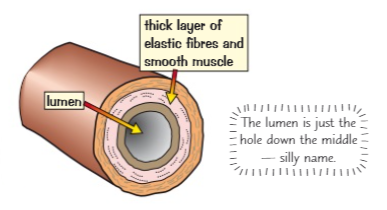
Arteries
They carry blood away from the heart. They have thick, strong and elastic walls to manage the high pressure of the blood
11
New cards
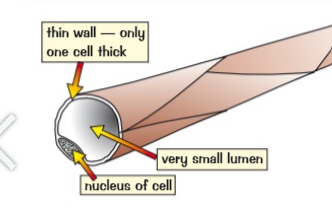
Capillaries
Carries blood around the body. They have permeable walls to exchange substances with cells and the walls are usually 1 cell thick to increase the rate of diffusion
12
New cards
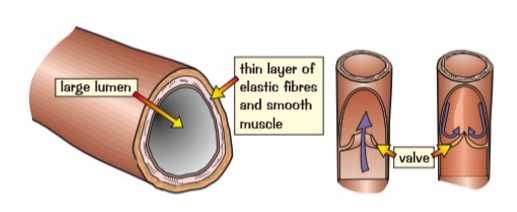
Veins
Carries blood back to the heart. They have a large lumen and valves to accommodate the low blood pressure and to keep it flowing in the right direction
13
New cards
Blood
A tissue of many similar cells working together to transport substances around the body
14
New cards
Plasma
A pale, yellow liquid that makes up the majority of the blood. it carries almost everything that needs being transported around the body including red blood cells, white blood cells, platelets, water, hormones and antibodies
15
New cards
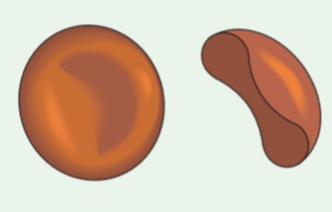
Red blood Cells
Biconcave cells which transport oxygen around the body. They are packed with haemoglobin and have no nucleus to make more room for it. They are also flexible so that they can fit into even the smallest capillaries.
16
New cards
Haemoglobin
A substance within red blood cells which gives them the red colour. It binds with the oxygen in the lungs to form oxyhaemoglobin which is how the oxygen is transported
17
New cards
Receptors
They detect a stimulus in the surroundings and sends electrical impulses to the central nervous system to coordinate a response.
18
New cards

Central nervous system (CNS)
It consists of the brain and spinal cord. When electrical impulses are received from a receptor it coordinates a response and then sends that response to an effector.
19
New cards
Effector
Usually a muscle or gland which acts in accordance with the information sent by the CNS after a stimulus is detected.
20
New cards
Sensory neurones
They send electrical impulses from a receptor to the CNS
21
New cards
Motor neurones
They send information from the CNS to an effector
22
New cards

Neurones
nerve cells which go all around the body. Neurones have branched endings so that they can connect with other neurones and are long which speeds up transmissions. Electrical impulses travel through the axon of the neurone. The axon is surrounded by a myelin sheath which acts as an electrical insulator and speeds up he transmission.
23
New cards
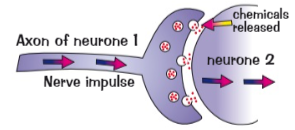
Synapse
The tiny gap between two neurones. the electrical impulse in one triggers chemicals to be released and diffuse across the gap. receptor molecules in the next neurone detect these impulses and continue the impulse.
24
New cards
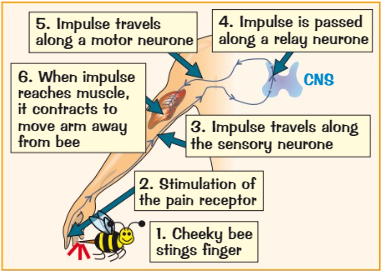
Reflex arc
What is responsible for any involuntary reflexes that the conscious brain isn’t involved in. When a receptor detects a stimulus and sends an impulse along a sensory neurone, instead of travelling all the way to the brain, a relay neurone in the spinal cord sends a response.
25
New cards
Cerebral cortex
The outer part of the brain which is responsible for consciousness, language, memory and intelligence
26
New cards
Cerebellum
Found at the base of the brain and is responsible for conscious movement
27
New cards
Brain stem
It connects the brain to the spinal cord and is responsible for unconscious movements like blinking and the heartbeat.
28
New cards
Studying patients with brain damage
If a small part of the brain malfunctions or is damages, its’ effect on the person can explain which part of the brain is responsible for what. This could be considered morally wrong as a patient may not be able to give informed consent.
29
New cards
Electrically stimulating the brain
By pushing a small electrode into the brain tissue and sending an impulse through it you can cause a bodily response which can tell you which parts of the brain is responsible for what
30
New cards
fMRI
Functional magnetic resonance imaging can show you which parts of the brain are stimulated during certain activities within the machine.
31
New cards
Treating the Brain
Treating the brain can be particularly difficult because: certain afflictions like tumours on certain parts of the brain cannot be removed without causing an excess of damage; some treatments for problems with the CNS can cause permanent damage and neurones don’t undergo mitosis so do not repair themselves making damage much harder to repair
32
New cards
Endocrine system
A collection of glands which produce responses for both internal and external stimuli
33
New cards
Hormones
Chemicals released from endocrine glands. They are released directly into the blood and are carried throughout the body however only produce a response from particular effectors which have receptors for the hormones to bind themselves to and stimulate a response.
34
New cards
Adrenaline
When the brain detects a stressful situation, it sends impulses to the adrenal glands which secrete adrenaline. This adrenaline binds to receptors in the heart and causes the heart to conteacts quicker with more force which raises heart rate and blood pressure. this allows cells tor ecieve more oxygen for increased respiration.
It also binds to receptors in the liver which causes the liver to break down its glucagon stores to release glucose which increases the blood glucose level
It also binds to receptors in the liver which causes the liver to break down its glucagon stores to release glucose which increases the blood glucose level
35
New cards
Thyroxine
Released by the thyroid gland, it is responsive for regulating the metabolic rate. It is released in response to TSH (thyroid stimulating hormone) being released from the pituitary gland. It is regulated using a negative feedback loop.
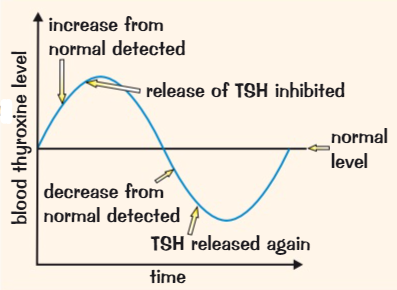
36
New cards

Menstrual cycle
Without it, sexual reproduction would be impossible. It is controlled by 4 hormones and takes place over 4 stages:
Day 1 is when menstruation, the shedding of the uterine lining, starts.
Day 4 from day 4 - day 14 the lining is repaired until it becomes a thick spongy layer ready to home a fertilised egg cell
At about day 14 an egg is developed and then released (ovulation)
The lining is then maintained for about 14 days until day 28. Without a fertilised egg the cycle will restart.
Day 1 is when menstruation, the shedding of the uterine lining, starts.
Day 4 from day 4 - day 14 the lining is repaired until it becomes a thick spongy layer ready to home a fertilised egg cell
At about day 14 an egg is developed and then released (ovulation)
The lining is then maintained for about 14 days until day 28. Without a fertilised egg the cycle will restart.
37
New cards
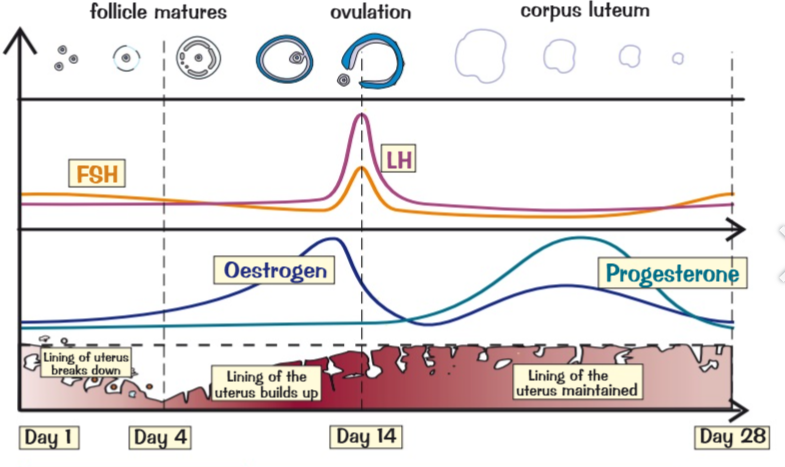
FSH (follicle stimulating hormone)
Released by the pituitary gland, it causes a follicle (an egg cell and its’ surrounding cells) to mature and also stimulates oestrogen production. Its’ production peaks at around day 14, ovulation
38
New cards
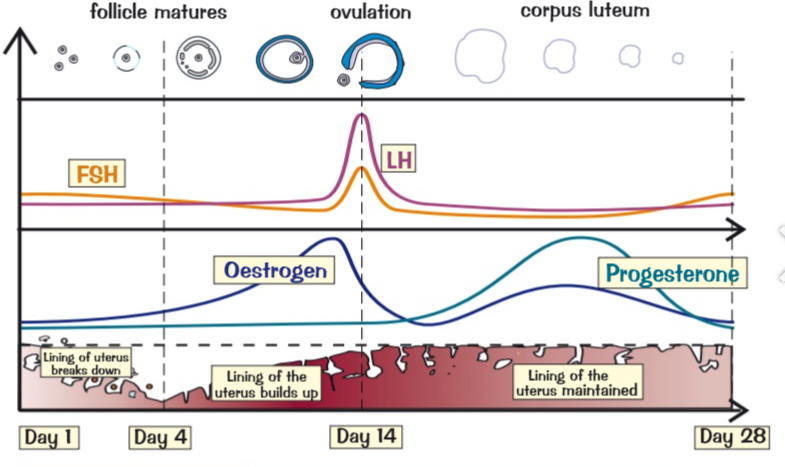
Oestrogen
Released by the ovaries, it causes the lining of the uterus to thicken and grow. Its’ production peaks just before ovulation
39
New cards
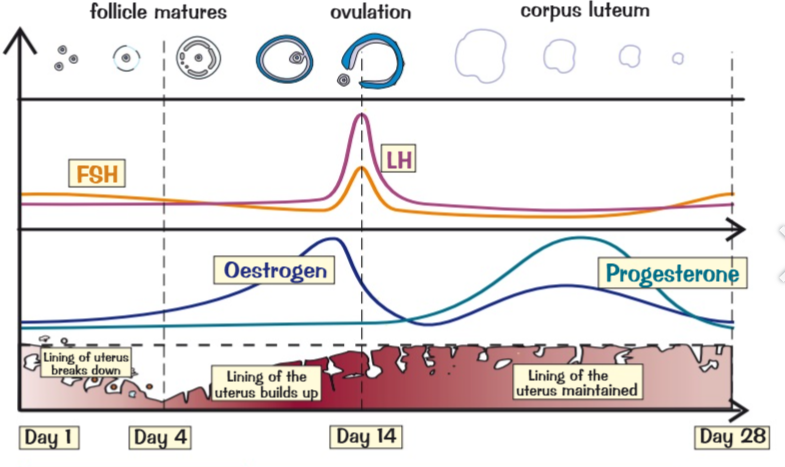
LH (luteinising hormone)
Released by the Pituitary gland, It surges around day 14 causing the follicle to rupture and the egg to be released (ovulation). It then stimulates the follicle to develop into corpus luteum which produces progesterone
40
New cards
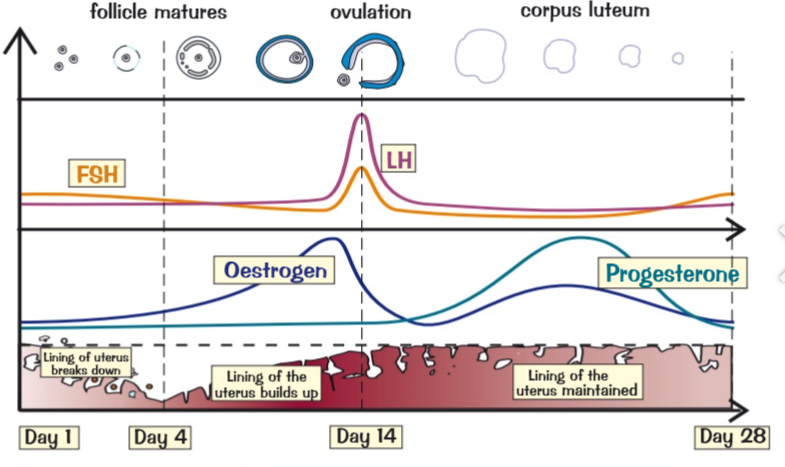
Progesterone
Released by the ovaries, it maintains the uterus lining in preparation for implantation and inhibits the release of LH and FSH. When progesterone levels fall (before day 28), and there’s a low oestrogen level the uterus lining breaks down. Low progesterone levels allow for a production of FSH to begin, restarting the menstrual cycle
41
New cards
Infertility
Being unable to reproduce naturally. In some cases it is due to a lack of FSH or LH in which case it can be injected to induce ovulation.
42
New cards
In Vitro Fertilisation
A way of artificial procreation where egg cells from a woman and sperm cells from a man are collected and grown into embryos. A number of these embryos are implanted into the woman to create a pregnancy. before egg collection, FSH and LH are injected to stimulate egg growth and therefore improve collection.
43
New cards
Hormonal Contraceptive - Progesterone
Contraceptive methods such as the injection, implant, mini-pill and intrauterine system use progesterone to block pregnancy. The progesterone makes a thick cervical mucus to prevent sperm, it thins the uterine lining to prevent implantation and inhibits the production of LH and FSH.
44
New cards
Hormonal Contraceptive - Progesterone + Oestrogen
Contraceptive methods such as the combined pill and the patch use progesterone to block pregnancy. The progesterone makes a thick cervical mucus to prevent sperm, it thins the uterine lining to prevent implantation and, with both progesterone and oestrogen, inhibits the production of LH and FSH
45
New cards
Barrier methods
A non-hormonal contraceptive method such as a condom (worn over the penis during sex), a female condom (worn inside the vagina during sex) and the Diaphragm (fit over the cervix and uses spermicide). These methods physically stop the sperm from meeting the egg and are upwards than 90% effective.
46
New cards
Intrauterine Device
A T-shaped copper device which kills sperm and prevents implantation. a 99% effective method lasting up to 10 years.
47
New cards
Sterilisation
The cutting or tying of tubes to prevent ejaculation or eggs travelling from the ovaries to the uterus.
48
New cards
Natural contraception
This involves methods such as not having sex during a woman's fertile window or “withdrawal” before ejaculation.
49
New cards
Contraception - Side effects
Any method of contraception “done wrong” won’t work which can be highly likely; Any method requiring medical input can cause a lot of discomfort; Contraception that has to be taken everyday such as the pill could be forgotten about; Condoms are the only type of contraception that can prevent the transmission of STI’s and hormonal methods can have hundreds of side-effects.
50
New cards
Homeostasis
The body needs to maintain constant conditions (such as water and glucose levels and body temperature) to survive. This is that process. It uses receptors, nerves, hormones and effectors to maintain ideal conditions and are mainly antagonistic effectors.
51
New cards
Negative feedback loop
When receptors detect a change in the body and use antagonistic effectors to reverse the change.
52
New cards
High Temperature
When the hypothalamus detects high temperature in the body: erector muscles relax so hairs lay flat; lots of sweat is produce which, once evaporated, transfers a lot of energy into the surrounding and vasodilation occurs so the blood is closer to the surface and can transfer more energy to the surroundings.
53
New cards
Low Temperature
When the hypothalamus detects low body temperature: erector muscle contract which makes hairs stand up, trapping an insulating air layer above the skin; vasoconstriction occurs so less energy is transferred into the environment and muscle contraction (shivering) occurs which needs respiration to transfer energy and warm the body.
54
New cards
Water Content
Body cells are surrounded by tissue fluid which allows water to move into or out of the cell via osmosis. Too much water and the cell bursts (lysis) too little and the cell shrinks. If the water content is balanced the cell will stay the same.
55
New cards
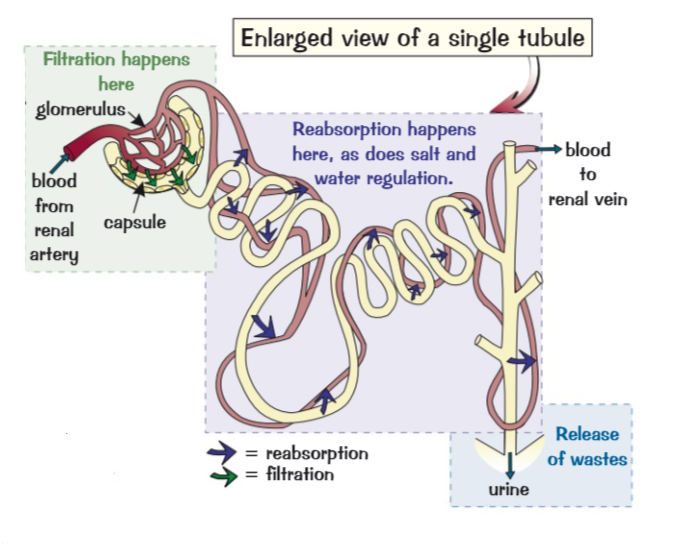
Urine Formation
Kidneys contain hundreds of little structures called tubules. Blood flows at high pressure through the glomerulus where molecules including water, sugar, salt and urea are separated into the capsule and the liquid continues along the tubule where useful substances are reabsorbed. Sugar, sufficient salt and sufficient water is reabsorbed but excess salt, water and anything not reabsorbed forms urine.
56
New cards
Water loss
When the hypothalamus detects low water content, it instructs the Pituitary gland to secrete anti-diuretic hormone which causes the kidneys to reabsorb more water, causing only small amounts of dark, concentrated urine.
57
New cards
Water Gain
When the hypothalamus detects high water content, it prevents the pituitary gland from secreting anti-diuretic hormone, so the kidneys reabsorb less water. This causes higher quantities of low concentrated urine to be produced.
58
New cards
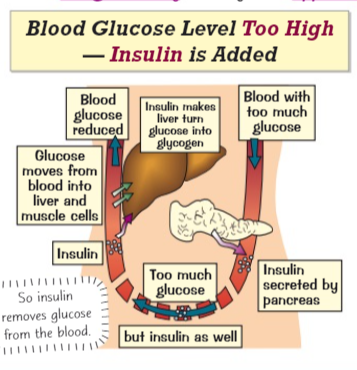
High Blood Glucose
When the pancreas detects high blood glucose, it secretes insulin which causes more glucose to move from the blood into the liver and muscle cells, lowering the glucose levels.
59
New cards
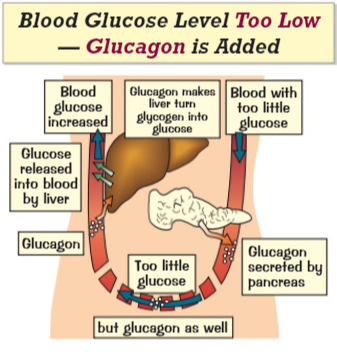
Low Blood Glucose
When the Pancreas detects low blood glucose it secretes Glucagon which causes glucose to be released from the liver into the blood therefore raising blood glucose levels.
60
New cards
Type 1 Diabetes
Type 1 diabetes is when the body stops producing insulin so blood sugar levels can rise to lethal amounts. This is usually treated which insulin injections (dependent on amount of exercise and diet of the person). The insulin makes the excess of glucose be absorbed.
61
New cards
Type 2 Diabetes
Type 2 diabetes is when the body stops responding to insulin and the chances of getting it are increased for people who are overweight. It can be treated by a healthy diet, frequent exercise and weight loss. In some cases medication and insulin injections are used.
62
New cards
Eye
A sense organ receptive to light
63
New cards
Cornea
A transparent outer layer of the eye that refracts light into it.
64
New cards
Pupil
The hole in the middle of the eye which allows light to enter it.
65
New cards
Iris
This controls the amount of light allowed into the eye as too much can damage the retina. When there is a lot of light, the iris increases in size to reduce the light entering the eye. When there is little light, the iris decreases in size allowing more light into the eye
66
New cards
Lens
refracts light to focus it onto the retina
67
New cards
Retina
An area consisting of light receptor cells
68
New cards
Ciliary muscles and Suspensory ligaments
These control the shape of the lens. The muscles contract which slackens the ligaments forcing the lens to become fat, increasing the amount light refracts to see near objects. the muscles relax, pulling the ligaments tight forcing the lens to become thin to see distant objects.
69
New cards
Optic nerve
Carries impulses from the retina to the brain
70
New cards
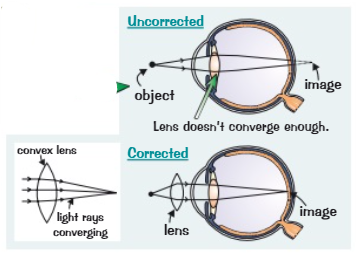
Long Sightedness
This occurs when the lens doesn’t refract light enough so the rays don’t converge onto the retina but behind it instead or the eyeball itself is too short. This causes people to be unable to focus on near objects. This can be corrected by convex lenses which starts convergence before the light enters the eye.
71
New cards
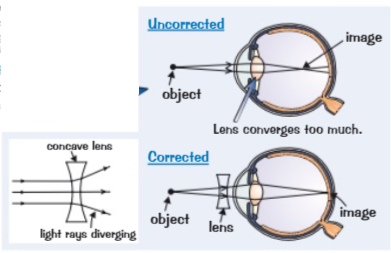
Short sightedness
Tis happens when the lens is the wrong shape making the light converge too much or when the eyeball is too long meaning the light converges before it reaches the retina. This makes people unable to focus on distant objects. This can be corrected with concave lenses which makes the light diverge before it reaches the retina.
72
New cards
Cataracts
This occurs when the eye tissue begins to degrade and a cloudy patch is created on the lens. This makes a person have blurred vision, see less vivid colours and difficulty seeing in bright light. This is most likely to happen to the elderly and can be corrected with an artificial lens to replace the faulty one. Complications could cause damage to the retina.